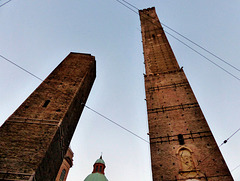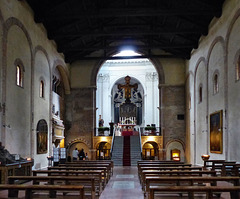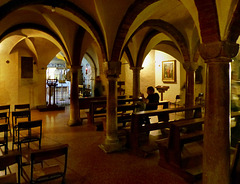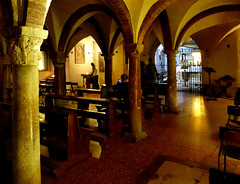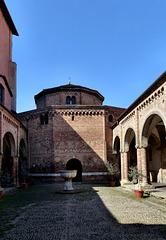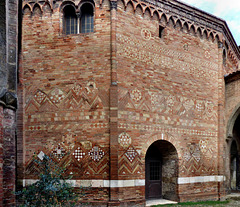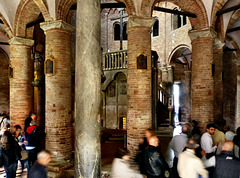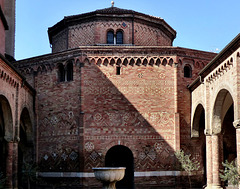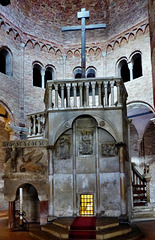
Emilia-Romagna
All photos just have in common, that they were taken in the Italian region Emilia-Romagna.
Bologna - Bottega Della Luce
| |
|
|
A night stroll through the city of Bologna, capital of the Emilia-Romagna. Not only Osram light bulbs, as well as a wide range of electrical appliances are offered here - in daytime.
Bologna - Le due torri
| |
|
These two towers are a landmark of Bologna.
It is estimated, that within the 12th century the number of towers in Bologna was up to 180. In medieval times the city must have had a skyline like Manhattan today. From the end of the 13th century on many towers were taken down, others collapsed. Even in the early 20th century two towers got demolished. About twenty medieval towers still exist, but all of them are dismanteled to the hight of the surrounding buildings.
All but these two, both erected between 1109 and 1119. !
The Asinelli Tower
initially had a height of 70m and was raised later to the current 97.2 m. When in the 14th century the tower was used as a prison and small stronghold, an aerial footbridge was added at a height of 30 m above ground connecting to the neighbouring Garisenda Tower. This bridge was destroyed during a fire in 1398. Lightning often caused damage. Since 1824 a lightning rod is installed here.
The Garisenda Tower
once had a height of 60m, but due to a yielding of the ground a significant incline started. The tower was becoming more and more dangerous and between 1351 and 1360 it was cut off. So the tower today has a height of 48m with an overhang of 3,2 m. In the early 15th century, the tower was bought by the "Arte dei Drappieri" ("Guild of of Drapers"). The guild owned it upto the 19th century.
Bologna - Night Rock
| |
|
Strolling through Bologna at late evening. A rock band performs in front of a coffee shop on the Via Ugo Bassi. Seen in the background is the Asinelli Tower.
Bologna - Sette Chiese
| |
|
"Sette Chiese" (= "Seven Churches") or "Santa Gerusalemme" (= "Holy Jerusalem") encompasses a complex of interconnected religious edifices, erected between the 5th and the 13th century.
According to tradition Saint Petronius, a bishop during the 5th century, built the first basilica. He actually wished a building that recalled the Church of the Holy Sepulchre in Jerusalem.
"Sette Chiese" is a very complex structure, so this model gives an overview.
Bologna - Basilica di Santo Stefano
| |
|
|
The "Basilica di Santo Stefano" is as well known as "Sette Chiese" (= "Seven Churches") that encompasses a complex of interconnected religious edifices, erected between the 5th and the 13th century. - See previous upload for an overview.
According to tradition Saint Petronius, a bishop during the 5th century, built the first basilica. He actually wished a building that recalled the Church of the Holy Sepulchre in Jerusalem.
Seen here is the facade of the Chiesa del Crocifisso. To the left is the Basilica del Sepolcro ("Basilica of the Holy Sepulchre"), a rotunda, further left (behind the white truck) the facade of the Basilica dei SS. Vitale e Agricola.
Bologna - Chiesa del Crocifisso
| |
|
|
The Chiesa del Crocifisso (= "Church of the Cross") is part of the "Basilica di Santo Stefano" known as "Sette Chiese" (= "Seven Churches") that encompasses a complex of interconnected religious edifices, erected between the 5th and the 13th century.
The Chiesa del Crocifisso is dated to the 8th/9th century, though it got altered later in many ways. Seen here is the nave. Under the risen choir is a large crypt.
Bologna - Chiesa del Crocifisso
| |
|
The Chiesa del Crocifisso (= "Church of the Cross") is part of the "Basilica di Santo Stefano" known as "Sette Chiese" (= "Seven Churches") that encompasses a complex of interconnected religious edifices, erected between the 5th and the 13th century.
The Chiesa del Crocifisso is dated to the 8th/9th century, though it got altered later in many ways. Seen here is the Baroque choir.
Bologna - Chiesa del Crocifisso
| |
|
The Chiesa del Crocifisso (= "Church of the Cross") is part of the "Basilica di Santo Stefano" known as "Sette Chiese" (= "Seven Churches") that encompasses a complex of interconnected religious edifices, erected between the 5th and the 13th century.
The Chiesa del Crocifisso is dated to the 8th/9th century, though it got altered later in many ways. The Romanesque crypt, below the risen choir, has a nave and two aisles on either side.
Bologna - Chiesa del Crocifisso
| |
|
|
|
The Chiesa del Crocifisso (= "Church of the Cross") is part of the "Basilica di Santo Stefano" known as "Sette Chiese" (= "Seven Churches") that encompasses a complex of interconnected religious edifices, erected between the 5th and the 13th century.
The Chiesa del Crocifisso is dated to the 8th/9th century, though it got altered later in many ways. The Romanesque crypt, below the risen choir, has a nave and two aisles on either side.
Bologna - Basilica del Sepolcro
| |
|
|
The Basilica del Sepolcro is part of the "Basilica di Santo Stefano" known as "Sette Chiese" (= "Seven Churches") that encompasses a complex of interconnected religious edifices, erected between the 5th and the 13th century.
Already within the 5th century Bishop Petronius built a "Holy Sepulchre" here, recalling the Church of the Holy Sepulche in Jerusalem, consecrated in 335.
Petronius´ church got severely damaged during the devastating invasions of Hungarian troops in the tenth century. The octogonal church got rebuilt a century later by Benedictian monks. Here is is seen from the cloister named "Cortile di Pilato" ("Pilate's courtyard").
Bologna - Basilica del Sepolcro
| |
|
|
The Basilica del Sepolcro is part of the "Basilica di Santo Stefano" known as "Sette Chiese" (= "Seven Churches") that encompasses a complex of interconnected religious edifices, erected between the 5th and the 13th century.
Already within the 5th century Bishop Petronius built a "Holy Sepulchre" here, recalling the Church of the Holy Sepulche in Jerusalem, consecrated in 335.
Petronius´ church got severely damaged during the devastating invasions of Hungarian troops in the tenth century. The octogonal church got rebuilt a century later by Benedictian monks from red bricks. The outer walls are adorned with Cosmatesque mosaics.
Bologna - Basilica del Sepolcro
| |
|
The Basilica del Sepolcro is part of the "Basilica di Santo Stefano" known as "Sette Chiese" (= "Seven Churches") that encompasses a complex of interconnected religious edifices, erected between the 5th and the 13th century.
Already within the 5th century Bishop Petronius built a "Holy Sepulchre" here, recalling the Church of the Holy Sepulche in Jerusalem, consecrated in 335.
Petronius´ church got severely damaged during the devastating invasions of Hungarian troops in the tenth century. The octogonal church got rebuilt a century later by Benedictian monks from red bricks. The dome above is dodecagonal. It is supported by 12 columns. Some of them are probably spolia that got reused here.
Bologna - Basilica del Sepolcro
| |
|
The Basilica del Sepolcro is part of the "Basilica di Santo Stefano" known as "Sette Chiese" (= "Seven Churches") that encompasses a complex of interconnected religious edifices, erected between the 5th and the 13th century.
Already within the 5th century Bishop Petronius built a "Holy Sepulchre" here, recalling the Church of the Holy Sepulche in Jerusalem, consecrated in 335.
Petronius´ church got severely damaged during the devastating invasions of Hungarian troops in the tenth century. The octogonal church got rebuilt a century later by Benedictian monks from red bricks. The outer walls are adorned with Cosmatesque mosaics.
Bologna - Basilica del Sepolcro
| |
|
The Basilica del Sepolcro is part of the "Basilica di Santo Stefano" known as "Sette Chiese" (= "Seven Churches") that encompasses a complex of interconnected religious edifices, erected between the 5th and the 13th century.
Already within the 5th century Bishop Petronius built a "Holy Sepulchre" here, recalling the Church of the Holy Sepulche in Jerusalem, consecrated in 335.
Petronius´ church got severely damaged during the devastating invasions of Hungarian troops in the tenth century. The octogonal church got rebuilt a century later by Benedictian monks from red bricks. The dome above is dodecagonal. It is supported by 12 columns.
In the center of the "Basilica del Sepolcro" is this structure, that reminds of the Calvary. A mountain with a cross on top over a cave. The pulpit (right) bears the Evangelists´ symbols. In 1141 the relics of Saint Petronius (aka "Bishop Petronus") were rediscovered here - since then they are in the cave of this Calvary.
Bologna - Basilica del Sepolcro
| |
|
|
The Basilica del Sepolcro is part of the "Basilica di Santo Stefano" known as "Sette Chiese" (= "Seven Churches") that encompasses a complex of interconnected religious edifices, erected between the 5th and the 13th century.
Already within the 5th century Bishop Petronius built a "Holy Sepulchre" here, recalling the Church of the Holy Sepulche in Jerusalem, consecrated in 335.
Petronius´ church got severely damaged during the devastating invasions of Hungarian troops in the tenth century. The octogonal church got rebuilt a century later by Benedictian monks from red bricks. The dome above, seen here, is dodecagonal. It is supported by 12 columns.
Bologna - Basilica dei San Vitale e Sant'Agricola
| |
|
The "Basilica dei San Vitale e Sant'Agricola" is part of the "Basilica di Santo Stefano" known as "Sette Chiese" (= "Seven Churches") that encompasses a complex of interconnected religious edifices, erected between the 5th and the 13th century.
This church is dedicated to the Saints Vitalis and Agricola, venerated martyrs, who are considered to have died at Bologna about 304, during the Diocletian persecution.
End of the 4th century Bishop Eusebius of Bologna, announced the discovery of the relics of Vitalis and Agricola. When he reburied them, Saint Ambrose, Bishop of Milan, was here and his writings about the event led to popular veneration of these saints.
The church first was named "San Vitale ed Agricola in Arena", as it may have been built over the remains of an amphitheatre where the martyrdom of Vitalis and Agricola had taken place.
Within the 15th century a sarcophag was found here bearing the inscription "Symon". A rumor spread, that the original tomb of Simon Peter - aka Saint Peter. Suddenly pilgrims headed to Bologna instead to Rome. To stop that "business" Pope Eugenius IV ordered to fill up this church with earth - and is stayed so - for 70 years.
Bologna - Basilica dei San Vitale e Sant'Agricola
| |
|
|
The "Basilica dei San Vitale e Sant'Agricola" is part of the "Basilica di Santo Stefano" known as "Sette Chiese" (= "Seven Churches") that encompasses a complex of interconnected religious edifices, erected between the 5th and the 13th century.
This church is dedicated to the Saints Vitalis and Agricola, venerated martyrs, who are considered to have died at Bologna about 304, during the Diocletian persecution.
End of the 4th century Bishop Eusebius of Bologna, announced the discovery of the relics of Vitalis and Agricola. When he reburied them, Saint Ambrose, Bishop of Milan, was here and his writings about the event led to popular veneration of these saints.
The church first was named "San Vitale ed Agricola in Arena", as it may have been built over the remains of an amphitheatre where the martyrdom of Vitalis and Agricola had taken place.
Two Romanesque capitals flank the door.
Seen here may be Vitalis and Agricola. Legends tell that Agricola was a noble Christian, who converted his slave Vitalis to Christianity, what resulted in martyrdom.
To the left somebody is riding a dragon - and is just getting devoured. Well the two dragons will probably share the poor soul.
Bologna - Basilica dei San Vitale e Sant'Agricola
| |
|
|
The "Basilica dei San Vitale e Sant'Agricola" is part of the "Basilica di Santo Stefano" known as "Sette Chiese" (= "Seven Churches") that encompasses a complex of interconnected religious edifices, erected between the 5th and the 13th century.
This church is dedicated to the Saints Vitalis and Agricola, venerated martyrs, who are considered to have died at Bologna about 304, during the Diocletian persecution.
End of the 4th century Bishop Eusebius of Bologna, announced the discovery of the relics of Vitalis and Agricola. When he reburied them, Saint Ambrose, Bishop of Milan, was here and his writings about the event led to popular veneration of these saints.
The church first was named "San Vitale ed Agricola in Arena", as it may have been built over the remains of an amphitheatre where the martyrdom of Vitalis and Agricola had taken place.
Two Romanesque capitals flank the door.
In case Saint Vitale and Saint Agricola are seen on the left side of the door - and having in mind, that the place, where the church is now, may have been the "arena" where they were martyred, then the twelve heads may symbolize the crowd of spectators then have been in the amphitheatre.
Jump to top
RSS feed- Latest items - Subscribe to the latest items added to this album
- ipernity © 2007-2024
- Help & Contact
|
Club news
|
About ipernity
|
History |
ipernity Club & Prices |
Guide of good conduct
Donate | Group guidelines | Privacy policy | Terms of use | Statutes | In memoria -
Facebook
Twitter


